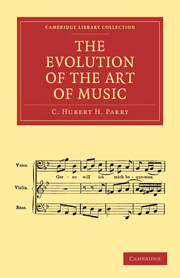Book contents
- Frontmatter
- PREFACE
- Contents
- CHAPTER I PRELIMINARIES
- CHAPTER II SCALES
- CHAPTER III FOLK-MUSIC
- CHAPTER IV INCIPIENT HARMONY
- CHAPTER V THE ERA OF PURE CHORAL MUSIC
- CHAPTER VI THE RISE OF SECULAR MUSIC
- CHAPTER VII COMBINATION OF OLD METHODS AND NEW PRINCIPLES
- CHAPTER VIII CLIMAX OF EARLY INSTRUMENTAL MUSIC
- CHAPTER IX BEGINNINGS OF MODERN INSTRUMENTAL MUSIC
- CHAPTER X THE MIDDLE STAGE OF MODERN OPERA
- CHAPTER XI THE MIDDLE STAGE OF “SONATA” FORM
- CHAPTER XII BALANCE OF EXPRESSION AND DESIGN
- CHAPTER XIII MODERN TENDENCIES
- CHAPTER XIV MODERN PHASES OF OPERA
- SUMMARY AND CONCLUSION
- INDEX
CHAPTER VII - COMBINATION OF OLD METHODS AND NEW PRINCIPLES
Published online by Cambridge University Press: 29 August 2010
- Frontmatter
- PREFACE
- Contents
- CHAPTER I PRELIMINARIES
- CHAPTER II SCALES
- CHAPTER III FOLK-MUSIC
- CHAPTER IV INCIPIENT HARMONY
- CHAPTER V THE ERA OF PURE CHORAL MUSIC
- CHAPTER VI THE RISE OF SECULAR MUSIC
- CHAPTER VII COMBINATION OF OLD METHODS AND NEW PRINCIPLES
- CHAPTER VIII CLIMAX OF EARLY INSTRUMENTAL MUSIC
- CHAPTER IX BEGINNINGS OF MODERN INSTRUMENTAL MUSIC
- CHAPTER X THE MIDDLE STAGE OF MODERN OPERA
- CHAPTER XI THE MIDDLE STAGE OF “SONATA” FORM
- CHAPTER XII BALANCE OF EXPRESSION AND DESIGN
- CHAPTER XIII MODERN TENDENCIES
- CHAPTER XIV MODERN PHASES OF OPERA
- SUMMARY AND CONCLUSION
- INDEX
Summary
The development of principles of design in music must inevitably wait upon the development of technique. Very little can be done with limited means of performance; and the adequacy of such means is dependent on the previous perfecting of various instruments, and on the discovery of the particular types of expression and figure which are adapted to them. One of the reasons why instrumental music lagged behind other branches of art was, that men were slow in finding out the arts of execution; and even when the stock of figures and phrases which were adapted to various instruments had become plentiful, it took composers some time to assimilate them sufficiently, so as to have them always ready at hand to apply to the purposes of art when composing. It was this which gave performers so great an advantage in the early days, and accounts for the fact that all the great composers of organ music in early days were famous organists, and all the successful composers of violin music were brilliant public performers. In modern times it is necessarily rather the reverse, and some of the greatest of recent composers have been famous for anything rather than for their powers as executants.
- Type
- Chapter
- Information
- The Evolution of the Art of Music , pp. 157 - 174Publisher: Cambridge University PressPrint publication year: 2009First published in: 1896



